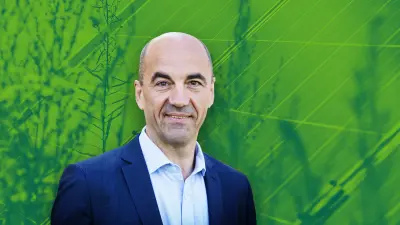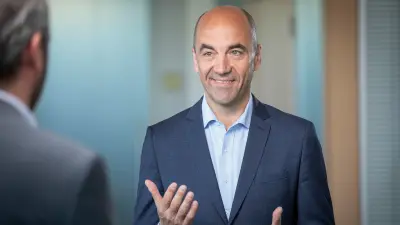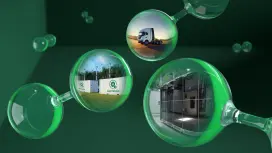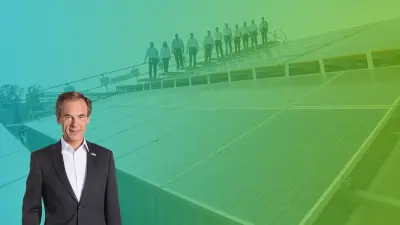Smart grids: Powering the future
In dialogue with the CEO of EWE

2021-07-20
Renewable energy means greener power, but it also brings a number of complex challenges with it. Stefan Dohler, CEO of EWE AG, one of the largest energy service providers in Germany, describes the role smart grids, data, and hydrogen will play in the electric energy system of the future.
There are a number of major challenges facing energy service providers across the planet. Global demand for energy has grown tenfold since the 1950s, with this trend set to continue in the future. As a result of climate change, it is incumbent on us to use energy more efficiently and conscientiously. We also have to shift away from fossil fuels and move towards renewable energy sources. “What took us 200 years to build up during the industrial era, we are now looking to remake in short order,” says Stefan Dohler, CEO of EWE AG, a company based out of Lower Saxony, Germany, that provides power, natural gas, and telecommunications services.
EWE has accomplished what many energy providers are now looking to do: 95 percent of the power it supplies via its grids is sourced from renewable energy sources. “We’re ten years ahead in the transformational shift. And we faced issues that everyone else on the market will face in a few years,” says Dohler. EWE’s goal is to be climate neutral by 2035, 15 years ahead of the targets dates set by the European Union, the US, and other countries. “It’s the most important issue our generation needs to tackle. I believe it is our duty to address the problem for the future wellbeing of our children and grandchildren,” states Dohler.
95 percent
of electricity fed into EWE’s power supply grids is green energy from renewable energy sources, making the company one of the true pioneers in the energy transition in Europe.
Millions of power generating systems

EWE has a clear advantage by being so close to the North Sea that made it easier for the company to switch over to renewable energies. “The region where we are located is very windy. We are near the coast, which gives us access to massive amounts of power generated by offshore wind farms. Added to that, we operate a number of underground storage facilities with capacity to meet our long-term needs,” explains Dohler. But just because the local conditions for renewables may be advantageous does not necessarily ensure success. Each of the growing number of individual systems has to be connected to a stable and reliable central system.
“For a very long time, a 100 or so large-scale power plants supplied power to all grids. That is set to change in the future. There will be millions of power generating systems, including wind farms or photovoltaic systems which are already available now,” reports Dohler. Customers will also play a new role. Prosumers, a portmanteau of the words producer and consumer, is the term Dohler uses to describe them. They not only buy power, but also generate and feed it into the public grid from their PV or similar system.
Forecasts predict that up to 20 percent of all power produced in Germany will be generated by prosumers. This will lead to a more decentralized energy market and stabilize the supply of renewables. On the flip side, this will increase the complexity of the energy infrastructure, which will require both automation and algorithms to manage.
Hydrogen as a power source
Another factor that will play a major role in the energy supply going forward is the dependency of renewable energy sources on the prevailing weather conditions. Photovoltaic systems tend to produce peak power on days when it is sunny. When it is not, they generate very little to feed into the grid. As a way to offset fluctuations in the amount of power supplied by the systems, large batteries or pumped storage plants are used to store the electricity and make it available when it is needed.
While this could be used to bridge short-term dips in the energy supply in Germany, a different solution is needed to cope with longer periods where there is not enough sun or wind. “Hydrogen is the only way to create an equilibrium in the electric energy system using long-term storage options built around clean gas,” says Dohler. Hydrogen can be produced sustainably from water and green electricity and can be converted back into electricity by fuel cells. In a project being carried out in Rüdersdorf, Germany, EWE is currently testing the storage of hydrogen in man-made underground caverns.
“The energy system of the future will be highly decentralized, making it impossible for anyone to manage, balance, or optimize it.”
Smart grids are essential
The task of managing power supply grids is made extremely difficult by the growing number of power generating systems and the erratic supply of power from them. “The energy system of the future will be highly decentralized, making it impossible for anyone to manage, balance, or optimize it,Ð states Dohler. For this reason, grids are being transformed into smart grids — intelligent distribution systems that process energy and data streams autonomously and automatically align power generation and consumption with each other. “This will require extensive use of smart technologies, and the Artificial Intelligence of Things (AIoT) is ideal for this task.”

AIoT is the combination of artificial intelligence in connected systems and devices with the Internet of Things (IoT). It can be deployed to collect data on individual systems, including the energy consumption of a production plant. This is then used to calculate consumption for the coming weeks as part of smart energy management.
To develop appropriate solutions, utilities need to work with technology partners who have expertise with sensors, actuators, artificial intelligence, and data management. “Public utilities are no longer able to go it alone. We are looking for strong alliances with companies like Bosch,” states Dohler.
Leveraging the wealth of data available
Digitalization generates large volumes of data in electrical grids, from power generation and feed-in to smart metering. “The data from the electric meter is available at such a level of detail that you could tell what TV show someone is watching at home,” Dohler explains. While that is well within the realm of technical possibility, the data is of course anonymized before it is processed. Grid operators use the data to optimize the power supply and develop new products and services.
For example, EWE has developed software that evaluates the movement patterns of electric vehicles along with the charging habits of drivers. This data is used to make sounder, more logical decisions on where to install charging stations. For instance, energy consumption data can be leveraged to help achieve climate goals. “One example of this is the EU taxonomy, which assesses everything in terms of its carbon footprint,” says Dohler. EWE itself provides an app that allows companies or private citizens to measure their carbon footprint and therefore promote more sustainable habits.
Transforming the system requires a strong commitment
Stefan Dohler estimates that Germany will be able to meet a majority of its electricity needs with renewable energy sources by 2030. Two things are required to make this happen. Firstly, Germany, which currently imports 70 percent of the primary energy it uses, will have to continue to procure large amounts of green power from other countries. This will be a highly complex undertaking from a logistical perspective, but Dohler is confident: “It’s technically feasible and, in my opinion, financially workable.”
Secondly, the infrastructure for renewables has to be further expanded, even if this will not always be popular with certain constituents. One such example is the construction of wind turbines. “If we are to achieve a climate-neutral world, we will also need to be open to the infrastructure required to make this possible,” says Dohler. How quickly the switch to a climate-friendly energy supply can be made therefore depends not only on decisions of policymakers, but also on the attitudes of each of us.

Stefan Dohler, 55
CEO of EWE AG
With the massive undertaking we have ahead of us, we need to be sure that the entire system works.
Stefan Dohler is a trained mariner and holds an MBA as well as an MS in aeronautical engineering. He worked at a shipyard and an engineering firm early in his career. From there he went on to join Hamburg energy provider HEW, a predecessor to Vattenfall GmbH, in 1998, where he held several executive positions in the company’s Finance, Networks, Production and Markets business areas. In 2012 Stefan Dohler joined the executive management team at the Vattenfall Group, where he would become the Group’s CFO four years later. He has served as CEO of EWE AG, headquartered in Oldenburg, Germany, since 2017.
Summary
The power grid of the future will be digitalized and decentralized. According to Stefan Dohler, smart solutions based on artificial intelligence are needed to manage the large number of energy flows. The data generated here can be used to optimize the grids. Hydrogen will play a major role as a store of energy.



